Decatur, GA—Tama Matsuoka Wong handed around velvety, scarlet, sumac fruit clusters for people to smell and touch. “The plant provides a tart, lemony spice in Middle Eastern cuisine,” she said, “a jelly, and a refreshing, thirst quenching Sumac-Ade, beloved of American Indians and godfather of foraging, Euell Gibbons.”
Wong visited Decatur this fall to promote “Foraged Flavor” which she co-wrote with chef Eddy Leroux. She strolled around the town square to see what was edible and found plenty, she said.
She has traveled an unusual road from financial attorney advising clients on the trading floors of New York, to wild foods forager and guardian of nature. Her Twitter tagline is “forager, weed eater, meadow doctor, lawyer and mother of three.” The New Jersey Forest Service named her 2007 Steward of the Year.
Her journey to professional forager started with a fateful gift of anise hyssop to chef Daniel Boulud, who used it in a vinaigrette over shrimp and melon and in a sorbet at restaurant Daniel. When she went to the kitchen to congratulate him, they struck a deal. He wanted “everything” from her New Jersey meadow.
Humor ensues as she wrangles giant garbage bags full of stinging nettles past suspicious guards onto the trading floor. “Bringing your laundry? Or is that garbage?” asked the smirking traders, she wrote. The British traders recognized the nettles from the hedgerows of England, according to Wong. Nettles have a deep herbal taste with notes of celery and mint, she says. Chef Daniel made them into a foam for hazelnut-encrusted scallops.
It’s clear she brought the intellectual tools needed for her first profession to her second. The book is excellently organized and well thought out. She may have taken “first do no harm” as her motto.
No harm to potential foragers and cooks: mushrooms are not included, because many of the tastiest wild mushrooms have poisonous lookalikes. Wong advises anyone interested in learning to forage mushrooms to consult the most reputable mycologist in his state.
Each plant is given its Latin name, a photograph, and a sketch, and the book is organized by season. Nearly all the “71 winner” plants in it can be found throughout North America.
No harm to the plants: Wong organizes them by green, yellow, and red. The colors mean how freely one should harvest them.
Green means the plant is an invasive non-native, and one is helping the ecosystem by removing them. Queen Anne’s Lace, garlic mustard, Japanese knotweed, chicory, plantain, and chickweed are among these.
Yellow means native plants, reasonably adaptable, but it’s best to take only about 20 percent of any group of them. Milkweed and cattails are in the yellow category.
Red plants are specialists, not adaptable. Once picked, they might not come back, and they depend on certain relationships, with soil, fungi, insects, or other plants. They should only be harvested from one’s own garden, Wong said. Mayapples and Trout Lilies are red category plants.
Love for people and the natural world shines in Wong’s voice. The foraging adventure has clearly enriched relationships with her chef partners and her family and friends.
A person could try a new plant each week by working through Leroux’s 88 wild plant recipes. Wong wrote that after a year of foraging, her family had fewer allergies, felt energetic, slept better, and had lost the desire to snack. Wild plants offer a variety of nutrients that farmed plants don’t, according to Wong.
Wong founded “meadows + more, connecting great food with nature.”
She came through Hurricane Sandy safely.






Friends Read Free